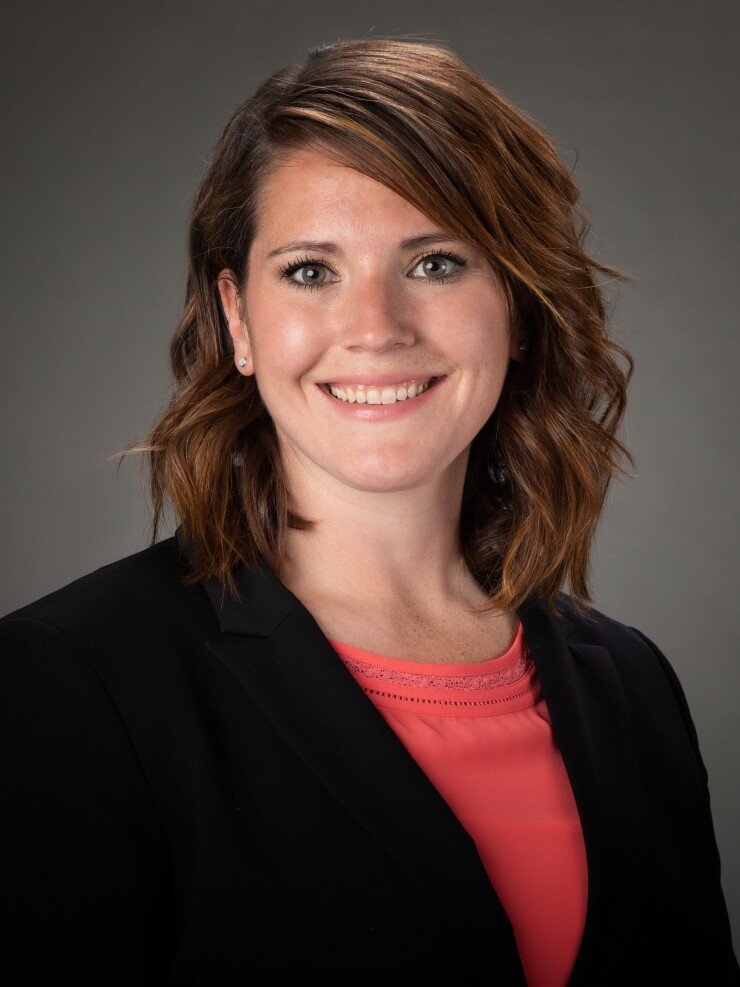
The credit union industry is facing a mass exodus of C-suite talent and other senior leaders over the next few years as baby boomers retire.
That has only been exacerbated by COVID-19. Executives who
The issue is so important that the National Credit Union Administration has issued a
All of this has prompted credit union boards to begin the search for new decision-makers as they put succession plans into motion. In turn, these openings create an opportunity for credit unions to get an infusion of fresh perspectives in the top ranks that are more reflective of their changing membership. However, there are concerns that hiring younger and more diverse candidates could create conflict with older workers who are less keen on change.
"Younger executives have been occasionally butting heads with older executives going as far back as banking in Renaissance Italy. It's not a particularly new phenomenon for there to be tensions between different generations of management," explained Joseph Fuller, a professor of management practice in general management at Harvard Business School. He studies the changing workforce for the school's Managing the Future of Work project.
As part of the 2022 report
Initial results looked promising, with roughly 80% of employers maintaining that their company's future success in the market hinged on investing time and effort into creating career advancement opportunities for low-wage staffers. Approximately 48% of employees felt that their company did an excellent or good job at increasing their pathways to higher positions.
But the data also uncovered a surprising disparity between the two groups. Roughly 53% of employees working in the finance and insurance industries ended up switching to a different sector after five years, as many felt that supervisors failed to provide them with guidance on what skills were needed to secure higher-paying positions.
Fuller emphasized that leaders need to prioritize retention in planning and creating a diverse workforce.
"It can be by job description, it can be by age and it can be by facility, but making sure that you're checking in with and understanding the headlines of whatever group of employees you're locked in on like morale and overall concerns … is a principle of good management," Fuller said.
To be certain, credit unions face stiff competition for talent, with the unemployment rate for July 2023 coming in at just 3.5%. Focusing on diversity, equity and inclusion and other issues important to workers can help management teams and boards not only better connect with employees, but also provide a broader suite of financial offerings to underserved communities.
"It's a very logical business conclusion to come to that you have to have your member base reflected in your board, your C-suite and in your staff who make key decisions," said Brooke Stone, vice president of culture and talent for the credit union trade group Cornerstone League in Plano, Texas, and a young professional herself. "You will be narrow-minded, and narrow in your offerings, if you don't have diverse perspectives of age, race, gender and all of the different cultural dynamics present in your field of membership represented internally and externally."

A wakeup call
For board members of credit unions who are reluctant to modernize outdated benefit policies and stagnant wages, the challenges of the Great Resignation have amplified talent sourcing woes by effectively pricing their institutions out of the market.
Simply addressing these deficiencies and executing a hiring round isn't enough to stop the outflow of employees, however. With younger generations of talent becoming increasingly mindful of their mental health in addition to their finances, respondents found that bolstering benefit policies for retirement, medical care and emotional wellbeing can help employees feel secure with their employers.
Aside from these programs, many institutions still struggle with identifying the skill sets they need in potential contenders as well as figuring out what perks would entice younger professionals to apply.
Marcus Cotton is vice president of executive recruiting at Cornerstone Resources, the professional staffing division of the Cornerstone League which specializes in filling vacancies from tellers to presidents and CEOs. He sits down with board members during the executive search process to understand what qualities they are looking for in a chosen candidate while also educating them on what the modern-day talent market is like using real-time data. He presents the data in a manageable "case study" format that covers everything from desirable fringe perks and 401(k) plans to salary ranges when looking at other credit unions of a similar asset size that are more successful in hiring campaigns.
"We educate the board on what we're seeing in the job hunting ecosystem and, to me, I don't really care about what you've read in any kind of publication. … I'm giving you real-time data as to what the market is showing right now," Cotton said.
These conversations and the findings "turn out to be eye-opening" for boards, who are surprised to learn that among other factors, the annual merit increases they once believed to be modest have "not been keeping up with the market," Cotton said.
In addition to senior leadership vacancies handled by the executive search department, Cornerstone also has a professional staffing division that addresses the remainder of the roles not handled by the executive arm. The company goes beyond standard posting and advertising tactics to reach out and connect with passive candidates through its relationships with major job boards, which serves to further narrow the pool of eligible choices and rule out those who aren't actively searching for work.
Although many credit unions are eager to fill top positions with those in the early to middle stages of their career, they still often select applicants toward the tail end of their careers in hopes of bringing on experience to support the organization's mission.
As a result, younger generations of professionals continue to find themselves at a crossroads looking for opportunities to grow their skill sets and move into desired leadership roles.
"Yeah, they're eager and yeah they're hungry, but they don't really have that complete tool set under their belt," Cotton said. "Every time I talk to a young executive, I encourage them to focus on going after the experience that they need and the money will come in time."
To broaden their experience, younger credit union workers could take a job at a smaller institution where they are more likely to be given greater responsibilities. But such a move usually means a sacrifice in wages.
Forgoing pay can be difficult for younger workers, especially those at the bottom of the pay scale. Wages and salaries for private sector workers increased by almost 5% in the 12-month period that ended in June 2023, after an almost 6% jump for the same period ending in June 2022, according to data from the Department of Labor's Bureau of Labor Statistics.
But that increase is not enough for many workers given the high inflation Americans have been struggling with. The Bureau's Consumer Price Index — which monitors the fluctuations in prices paid by consumers for goods and services — showed increases in the figures for rent, motor vehicle insurance, gasoline and food at home among other categories across the same 12-month period ending in June 2023. That's coupled with high interest rates.
"The smaller credit unions with $20 to $30 million of assets are dying on the vine," Cotton said. "They're starved for leadership and talent. … It might be a lateral career move that means taking a pay cut, but being a CEO of an organization that size means learning how to do a little bit of everything."
Money isn't the only factor driving Gen Z and millennials in their choice of employment, however.

Competitive compensation packages are important for attracting candidates, but allowing for a proper work-life balance and giving back to local communities also play a large hand in many decisions, said Sarah Hilton, senior vice president for the Texas-based credit union consulting firm D. Hilton Associates.
"We want to believe as an industry that the altruistic component of the credit union space is a driving factor when attracting candidates, but eventually they have families to feed and mortgages to pay," Hilton said. "The younger generation is very much driven by pay-for-performance and then there's a component that is going to be that work-life balance."
She underscored that the overall number of credit union executives who are willing to commit to a long-term role is shrinking, with the majority at or near retirement age. But despite the gradual influx of new talent into the industry, taking the time to look internally and cultivate staff for leadership roles is a crucial step for filling the gap.
"Due to the lack of shared knowledge among the top ranks, whether it's from practical hands-on experience, mentoring or continuing education, we have to continue to push people to acquire that all-around knowledge," Hilton said.
Rachel Guyselman, a 35-year-old senior vice president of risk and compliance with Credit Union 1 in Anchorage, Alaska, is a younger credit union executive who decided that gaining more experience was worth the trade off of a higher salary.
While working as an assistant branch manager for the $12.1 billion-asset Global Credit Union in Anchorage, Alaska, Guyselman was faced with a difficult choice. She could stay in her recently acquired position, or jump to a smaller credit union for less pay and the opportunity to advance toward a role with more responsibilities. The added skills were worth the sacrifice.
"That's really where my career took off," Guyselman said.
Guyselman was hired in 2014 as an operations specialist by the Ketchikan, Alaska-based Tongass Federal Credit Union. It was there that she began her foray into the world of compliance, becoming familiar with Bank Secrecy Act regulations and other risk analysis tools. She left Tongass in October 2020 and took other compliance-focused roles before joining the $1.5 billion-asset Credit Union 1 in May 2021.
Working for small institutions often means handling a little bit of everything "like a jack of all trades, and a master of none," according to Guyselman. But she said it was a rewarding path in the long run given the rapid expansion of her skill sets. "It's really awesome because you get to learn everything and be a part of everything, and I just ate it up," she added.
Hitting their stride
Paul James Jockisch is a member of a rare, and growing, class of professionals in the credit union industry. At 34, he was tapped to become the interim chief financial officer for Stanford Federal Credit Union in Palo Alto, California, and jumped into the full role just two years later — right at the precipice of the pandemic gripping the world.
Jockisch was no stranger to finance when he joined the $4.1 billion-asset Stanford FCU in 2012, bringing with him more than six years of experience as an auditor for the consulting firm Moss Adams. But when it came to credit unions, he was starting from the beginning.
"My story is probably not that different from many others that work in credit unions, which is the initial experience of not having any idea what a credit union is," Jockisch said.

He didn't anticipate how short his path to the C-suite as a young executive would be when compared to others across the credit union industry. He succeeded his retiring boss as the newly appointed controller after roughly three years of overseeing month-end reports and helping manage the accounting team.
With his new role came the added responsibility of directing the credit union's electronic services and internal audit teams.
It wasn't long before Jockisch was given the opportunity to move up again within the organization. He is the youngest member within Stanford FCU's top leadership. Working closely with the previous CFO helped ease the transition, but the comparatively short time frame in which Jockisch rose up through the credit union gave him pause on whether he was truly ready to fill the shoes of his predecessor.
The pandemic, and its trial-by-fire effect on the financial services sector, turned out to be the answer he needed. The first-time CFO navigated the credit union through an unprecedented economic crisis and honed the skills necessary to make the position his own.
Jockisch is leveraging his newfound perspective to pursue new technologies and partnerships that might have been disregarded by other leaders who had previous bad experiences with the suggestions.
"I definitely had less experience, and I used that in a good way because I'm not jaded to trying new things," Jockisch said. "I didn't necessarily have a bad taste in my mouth from something that was tried 20 years ago, but only a handful of people remember."
Recruiting diverse perspectives at all levels of the organization can often mean taking a risk on young professionals with little experience but some experts argue that the potential benefits — such as fresh ideas and enthusiasm — outweigh these concerns.
Credit Union 1's Guyselman draws from her past during the hiring process to isolate candidates who are mostly qualified for the position and eager to prove themselves — rather than the more experienced choices — emphasizing that those same chances led her to where she is today.
"That's something that sticks with me because I know that if I wasn't awarded these opportunities, I'm not sure where I would be today," Guyselman said.

Breaking the mold
However, creating these opportunities can lead to friction between longtime executives and newcomers to the credit union.
Such was the case for Hank Hubbard, the 63-year-old president and CEO of One Detroit Credit Union in Michigan, who has spent the last few years helping to restructure the $58 million-asset credit union's board of directors.
Over the years, One Detroit's membership has shifted from primarily white consumers to a diverse mix of lower income residents in the area. That prompted a discussion about how to best meet the needs of its members, the communities and the markets it serves.
"We had only one African American voice on the board but we still needed a louder voice, and the youngest person at that time was a couple years younger than me, so I figured we should dig a little deeper," Hubbard said.
Hubbard's previous role of mentoring high school students as part of the National Academy of Finance proved to be beneficial, as a handful of past pupils either currently sit on the credit union's board or did so in recent years.
Directors now reflect different segments of the current community — the board now has an African American majority — and have grown into their roles by combining past experiences with what they have learned from running a financial institution.
With the rapid pace of change among the leadership team, however, came new points of friction.
Hubbard recounted from his perspective that the previous board was more vocal about their feedback of his leadership compared to the new regime.
"It made it difficult for me during that initial adjustment period, because I know they liked my performance but they didn't see it the same way I did," Hubbard said. "Since they're still early in their careers, they're still building that frame of mind when it comes to understanding what qualifies as justifiable compensation."

The new board members are more passionate, however, about engaging in areas like cannabis banking and other products that cater toward previously unserved entrepreneurs.
While some look for financial know-how in the next class of professionals, others are prioritizing a creative mindset over technical skills.
In 2018, when Monica Belz was named president and CEO of Kaua'i Federal Credit Union in Lihue, Hawaii, she became the youngest person to ever take the helm at the credit union.
Part of Belz's approach to hiring focuses on enlisting those dedicated to helping the local communities rather than if they possess any background in financial services. This focus draws from her more than 20 years of progress in social impact community development and subsequent work with disaster relief, real estate development and other humanitarian projects.
"We are living through a time of massive intergenerational change [and] the workplace is adapting, while still reeling from a global pandemic. … One necessary response is that we need to embrace new technology quickly and meet prospective leaders where they are," Belz said.
Under her direction, the $143 million-asset Kaua'i FCU became one of the first organizations on the island to be certified as a community development financial institution and is in the beginning stages of building an economic resilience center to foster local diverse businesses. Now in her late 30s, Belz underscored the importance of welcoming new perspectives when plotting not only creating products and building an operating plan, but for better understanding the niche occupied by the credit union.
"We inspire each other, embrace our differences and hold each other accountable. … Our behaviors align with our values and create a shared sense of purpose," Belz said.






